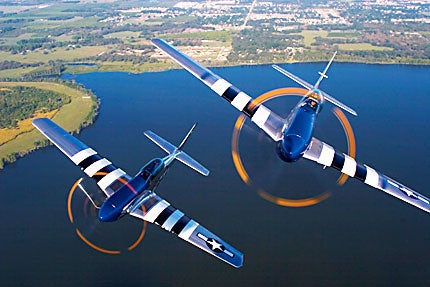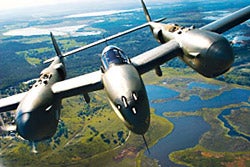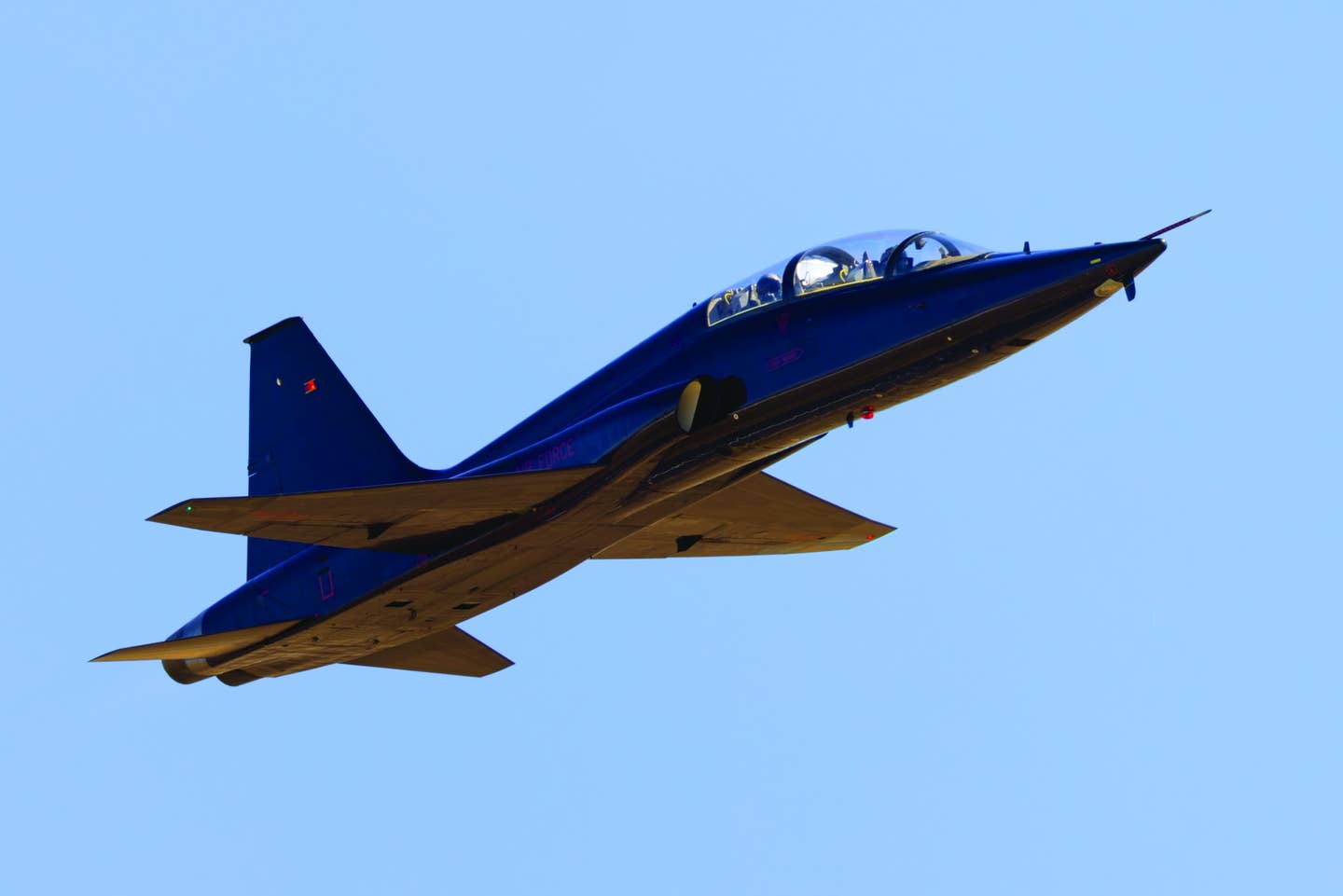Double Trouble
A tale of two P-51 Mustangs attracts a gathering of warbirds
 The P-51 Mustang is almost universally regarded as the best fighter to emerge from World War II. Talk to Bob Hoover, Chuck Yeager, Bud Anderson or any of a hundred other military test pilots, and they'll tell you the airplane was nothing less than a stroke of genius when it was introduced in 1942.
The P-51 Mustang is almost universally regarded as the best fighter to emerge from World War II. Talk to Bob Hoover, Chuck Yeager, Bud Anderson or any of a hundred other military test pilots, and they'll tell you the airplane was nothing less than a stroke of genius when it was introduced in 1942.
As I learned three years ago (flying with Lee Lauderback in Kissimmee, Fla.), it's a myth that the P-51 is an inherently dangerous airplane. Certainly, the powerful Mustang deserves special treatment, and it does have some quirks, but it flies pretty much like most other WWII fighters. Granted reasonable care and proper power management, the Mustang is an easy-flying airplane with few surprises inside the normal flight envelope.
Lee, president of Stallion 51, is in the business of providing Mustang check-outs to the very edge of that envelope. Lee's company specializes in teaching anyone with the means and the talent to fly the P-51. His pristine, two-seat, dual-control TF-51, Crazy Horse, is unquestionably one of the best-known Mustang trainers in the world, and Lee campaigns the immaculate warbird around the country on the air-show circuit when he's not instructing in it.
When I flew with Lee in 2001, he explained that few dual-control Mustangs had been built by North American during WWII, and fewer still are available today. Most of the Mustang trainers flying today, perhaps a dozen at most, are converted P-51Ds. In those days, Stallion 51 operated three TF-51s, the original Crazy Horse, Mad Max and Diamondback, all three airplanes converted P-51Ds. Lee also commented that Stallion 51 was working on converting another standard P-51D to the TF configuration, bringing the total of dual-control Mustangs to 13.
Enter Crazy Horse2. The Mustang was originally delivered to the RCAF at the close of WWII and became a civilian airplane in 1950. It passed through the hands of several owners after that, becoming a race plane at the Reno Air Races in the '70s and '80s, flying under the names Foxy Lady and Somethin' Else.
The airplane was finally purchased by Dick Thurman of Louisville, Ky., in 1997. Thurman, veteran of a previous P-40 restoration and a dedicated warbird enthusiast, was eager that the P-51 be more available to the warbird community rather than the personal transport of a single owner. Accordingly, after only three years of flying under the name Kentucky Babe, Thurman sold N351DT to Lee's Stallion 51 in 2000. Lee's brothers, Peter and Richard Lauderback, immediately launched into a full, ground-up restoration, and the result was a Best P-51 Award at the 2000 EAA AirVenture in Oshkosh, Wis.
Crazy Horse2 is a virtual duplicate of the original Crazy Horse and is intended to supplement the company's training fleet while the latter is undergoing a major overhaul. By the time you read this, Crazy Horse2 will have assumed the mantle of primary teaching machine for Stallion 51.
From a distance, the TF-51 and P-51D may look similar, but, in fact, the TF version incorporates a number of upgrades and improvements to adapt the original, single-seat Mustang to two seats and dual controls. One of the primary mods involves removing the standard 85-gallon auxiliary tank aft of the pilot's seat and installing a second seat, seat belts and shoulder harnesses in the rear position. This left the airplane with 180 gallons in the wings, plenty for flights of two hours or less.
While the missing fuselage tank allows provisions for carrying a passenger, aft occupants had best be short, especially if they're wearing a helmet. The standard, sharply tapered canopy presents a problem with headroom in the rear. Tall passengers have to scrunch down in the seat or bend forward slightly to fit into the rear pit. Owners of stock P-51s are sometimes reluctant to replace the canopy with a more squared-off, oblong version for fear of ruining the airplane's lines. Another factor that sometimes influences the decision to stay with the stock canopy is cost. The TF-51 canopy costs about $50,000.
Those who do mount the two-place canopy wind up with a comfortable two-seater, but enabling the rear seat with even a partial set of dual controls is a gargantuan undertaking. The minimum aft control installation demands stick, rudder pedals, throttle, prop and mixture, not to mention a full set of flight instruments and enough engine instruments to monitor manifold pressure, rpm, oil pressure, oil temperature and cylinder head temperature. Plumb all of that to the engine and appropriate controls, and you essentially have a total rebuild of the main fuselage.
"That's exactly what you have to do to convert a stock P-51D to a dual-control TF-51," explains Stallion 51 president Lee. "Parts aren't always readily available, and in some instances, you have to fabricate your own hardware. We were fortunate with Thurman's Mustang in that the airplane was already in great condition. That made our job considerably easier in converting the airplane to dual controls."
Crazy Horse2 now becomes arguably one of the world's most valuable single-engine warbirds, and Lee will press it into immediate service while the original Crazy Horse is down for maintenance, including a full engine overhaul of the Rolls-Royce Merlin V-1650 engine. That's not an easy process on an engine that has been out of production for 50 years.
During the war under the stress of combat, pilots often boosted power to "war emergency," 67 inches of manifold pressure. Such high power settings sometimes destroyed a Mustang engine in 100 hours or less, but Lee teaches techniques designed to make any Mustang Merlin last as long as 500 hours between overhauls.
 |
| Warbirds are wont to attract other warbirds. And such was the case when Lauderback added Crazy Horse2 to the skies over Florida. Immediately on the scene was Glacier Girl, the most famous and most expensively restored P-38 Lightning in the world. |
"Maximum takeoff power on the Mustang's Rolls-Royce engine is 61 inches of manifold pressure, but there's really no reason to use that much power unless you're in a bind," says Lee. "The full 61 inches delivers about 1,720 hp at 3,000 rpm. We suggest instead a maximum of 55 inches of manifold pressure for takeoff. Back in WWII, military avgas was rated as high as 130 octane, but today, 100 octane is the limit. Fifty-five inches won't cause detonation, it's plenty to lift two pilots plus full fuel, and it will still provide about 1,400 horsepower, enough to assure excellent performance."
We caught up with Stallion 51's two Crazy Horse Mustangs in conjunction with Sun 'n Fun 2005. A huge gaggle of warbirds was in town, including a little of everything from WWII.
It was too good an opportunity to pass up, and Pilot Journal was on hand in Kissimmee when Chino, Calif., Planes of Fame pilot Steve Hinton showed up with perhaps the world's most famous Lockheed P-38 Lightning, Glacier Girl. In case you've been living on the dark side of the moon and hadn't heard, Glacier Girl may be the most expensive single-engine warbird restoration ever. In total, its resurrection and renovation has demanded nearly 30 years of effort.
The Lightning was one of a flight of six P-38s and two B-17s that took off from Bluie West 8, Greenland (better known today as Sondre Strom Fjord), headed for ReykjavÃk, Iceland, in July, 1942. As a part of Operation Bolero, the flight was the second attempt to ferry warbirds across the North Atlantic to England via Greenland and Iceland. The gaggle of eight airplanes ran into characteristically bad weather over the Denmark Strait and turned back to Greenland. The airplanes ran out of fuel and crashed on the ice cap barely inland from the southeast coast of the island continent.
All the crews survived the crash landings without injury and were rescued, but the airplanes were left to the elements. Over the years, they gradually became buried underneath 270 feet of snow and ice. Recovery efforts began in the '70s with warbird fanatic David Talichet. At least three separate expeditions attempted to locate and raise the airplanes before the project was undertaken by Roy Shoffner of Middlesboro, Ky.
In 1992, Shoffner finally located and succeeded in raising the remnants of a single P-38, appropriately named Glacier Girl, from the depths of the ice cap. The severely damaged pieces were ferried to Oshkosh by a DC-3 in time for display at the 1992 AirVenture.
The ensuing restoration process required nearly a decade. When the rebuild was complete, Glacier Girl became one of only a half-dozen P-38s still flying. The airplane now resides at Roy Shoffner's Lost Squadron Museum in Middlesboro, but the museum regularly employs Steve Hinton, one of the world's most experienced warbird pilots, to fly the Lightning in air-show appearances around the United States.
Rounding out our flight of classic warbirds was Tim Savage's B-25 medium bomber, N3155G. The B-25 is a near-perfect photo ship for warbird pictures with its high cruising speed and aft-gun position converted to a photo port. Savage owns Warbird Digest, and his airplane has been specially painted in the magazine's colors and scheme.
Watching the three fighters in formation on Savage's B-25, it's hard to believe that they're all the result of multimillion-dollar restorations and that each is a classic reminder of an era of aviation now long gone. With the continuing efforts of folks such as Lee, Steve Hinton, Tim Savage, Roy Shoffner and Dick Thurman, the legacy of World War II aviation is in good hands.

Subscribe to Our Newsletter
Get the latest Plane & Pilot Magazine stories delivered directly to your inbox





